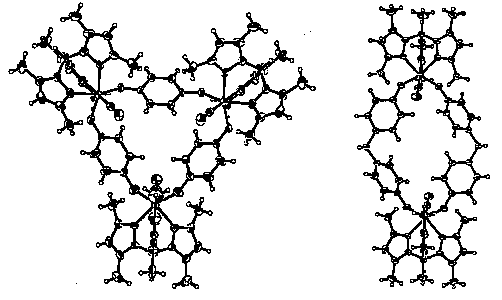
STRUCTURAL FEATURES OF METALLOCYCLOPHANES CONTAINING TWO, THREE AND FOUR OCTAHEDRAL METAL CENTRES. Thomas A. Hamor, Hongli Chen, Ferida S McQuillan, Timothy E. Berridge, Helen A. Hinton, and Christopher J. Jones, School of Chemistry, University of Birmingham, Birmingham B15 2TT, UK.
In the context of host-guest chemistry, the incorporation of transition metal atoms into cyclophanes provides a means of introducing new properties such as Lewis acidity or redox activity into the macrocyclic structures. These structures are based on -[M(Tp*)(Z)]- {Tp*=tris(3,5-dimethylpyrazolyl)hydroborate, M=Mo or W, Z=NO} units, linked by bifunctional agents, such as 1,4-dihydroxybenzene or 2,7dihydroxynaphthalene. Steric isomerism at the metal centres has been characterised; the accessibility of the central cavity to guest molecules is affected specifically by the orientation of the nitrosyl groups. Views of two- and three-metal centre macrocycles, based on area-detector X-ray data are shown below. Examples of four-metal centre structures, and other two and three-centre structures will be presented.
